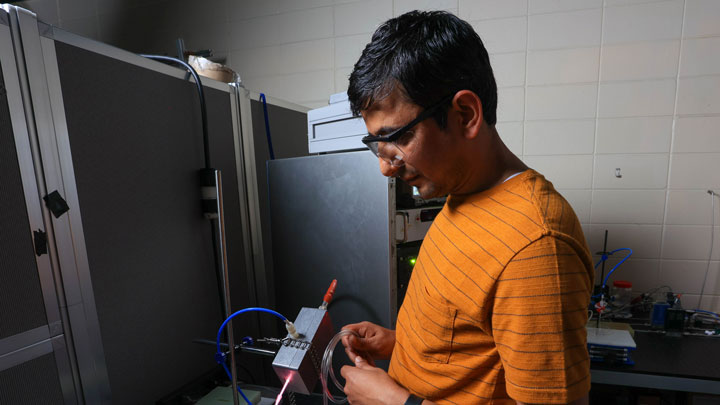A 10-year, $40 million federal investment in plasma science and engineering (PSE) efforts in Alabama managed at The University of Alabama in Huntsville (UAH) has produced tangible results that are very encouraging, according to Dr. Sandra Richardson, the section head for the Research Capacity and Competitiveness Section in the Office of Integrative Activities at the U.S. National Science Foundation. UAH is a part of the University of Alabama system.
Alabama is powering toward regional and national leadership in the high-technology PSE industry by building a homegrown collaborative base for research, new technology development and commercialization, as well as a knowledgeable workforce. Sustained support by the NSF’s Established Program to Stimulate Competitive Research (EPSCoR) is expanding Alabama’s expertise in plasma, a versatile, highly energized form of gas that has numerous scientific and commercial applications.

Michael Mercier / UAH
“Plasma science and engineering has the potential to transform many areas of modern society,” says Dr. Richardson, the NSF’s Alexandria, Va.-based leader for the effort. From the creation of novel materials, agricultural applications, sterilization and food safety, all the way to space weather forecasting, developing PSE transformational technologies will help to shape Alabama’s STEM (science, technology, engineering and math) enterprise, she says.
“The overall mission of EPSCoR is aligned with making Alabama a leader in plasma science and engineering research and workforce development,” says Dr. Richardson “We are excited to support the jurisdiction in growing in new ways to further expand participation and research competitiveness in the state’s research ecosystem.”
NSF EPSCoR Research Infrastructure Improvement (RII) Track-1 awards have backed two successive projects, both managed by UAH, and there’s the possibility of much larger funding ahead.
The current grant is the $20 million, five-year Future Technologies & enabling Plasma Processes (FTPP) project directed by Dr. Gary Zank, the Aerojet Rocketdyne chair of the Department of Space Science and also director of the Center for Space Plasma and Aeronomic Research (CSPAR) at FTPP partner UAH. This grant consecutively follows an earlier five-year, $20 million grant called CPU2AL: Connecting the Plasma Universe to Plasma Technology in Alabama.
FTPP is a coalition of nine Alabama universities and a research corporation. Besides UAH, partners include the University of Alabama, the University of Alabama at Birmingham, Auburn University, Tuskegee University, the University of South Alabama, Alabama A&M University, Alabama State University, Oakwood University and CFD Research Corp.
FTPP is considered a springboard to an even larger possible NSF grant of up to $160 million under a program that would fund Regional Innovation Engines. Achieving that level of support would establish Alabama as a southeastern regional hub for plasma expertise and boost the creation of thousands of high-paying technical careers in the state and region.
“A successful completion of two EPSCoR RII Track-1 awards, valued at $40 million over 10 years, along with the multiple other investments supporting CPU2AL and FTPP research, serve as a foundation for Alabama’s engagement with large-dollar funding opportunities at NSF and beyond,” says Dr. Richardson.
Each NSF engine will support the development of diverse regional coalitions of researchers, institutions, companies and civil society to conduct research and development that engages people in the process of creating solutions with economic and societal impacts. Through the process, NSF engines will train and develop the local workforce and grow regional innovation ecosystems throughout the U.S.